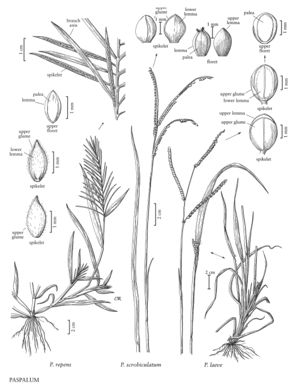Difference between revisions of "Paspalum scrobiculatum"
FNA>Volume Importer |
FNA>Volume Importer |
||
| Line 20: | Line 20: | ||
-->{{Treatment/Body | -->{{Treatment/Body | ||
|distribution=Md.;N.J.;Tex.;Ala.;Ga.;Pacific Islands (Hawaii) | |distribution=Md.;N.J.;Tex.;Ala.;Ga.;Pacific Islands (Hawaii) | ||
| − | |discussion=<p | + | |discussion=<p>Paspalum scrobiculatium is native to India. It has been found growing in widely scattered disturbed areas of the southeastern United States, possibly as an escape from cultivation. It is grown as a cereal (Kodo) in India.</p> |
|tables= | |tables= | ||
|references= | |references= | ||
| Line 36: | Line 36: | ||
|basionyms= | |basionyms= | ||
|family=Poaceae | |family=Poaceae | ||
| + | |illustrator=Linda A. Vorobik and Cindy Roché | ||
|distribution=Md.;N.J.;Tex.;Ala.;Ga.;Pacific Islands (Hawaii) | |distribution=Md.;N.J.;Tex.;Ala.;Ga.;Pacific Islands (Hawaii) | ||
|reference=None | |reference=None | ||
| Line 41: | Line 42: | ||
|publication year= | |publication year= | ||
|special status= | |special status= | ||
| − | |source xml=https:// | + | |source xml=https://bibilujan@bitbucket.org/aafc-mbb/fna-data-curation.git/src/314eb390f968962f596ae85f506b4b3db8683b1b/coarse_grained_fna_xml/V25/V25_1443.xml |
|subfamily=Poaceae subfam. Panicoideae | |subfamily=Poaceae subfam. Panicoideae | ||
|tribe=Poaceae tribe Paniceae | |tribe=Poaceae tribe Paniceae | ||
Revision as of 17:15, 30 October 2019
Plants annual. Culms 10-150 cm, erect or decumbent; nodes glabrous. Sheaths glabrous; ligules 0.3-1.2 mm, often with a row of hairs behind them; blades 5-30 cm long, 2-8(12) mm wide, flat, usually glabrous. Panicles terminal, with 1-5 digitately or racemosely arranged branches; branches 3-10 cm, diverging to spreading, persistent; branch axes 1.5-3 mm wide, broadly winged, glabrous, margins scabrous, terminating in a spikelet. Spikelets 1.8-3.2 mm long, 2-2.3 mm wide, solitary, diverging from the branch axes, ovate, glabrous, olive green to dark, glossy brown. Lower glumes absent; upper glumes as long as the lower lemmas, 5-7-veined; lower lemmas 3-5-veined; upper florets 2.5-3 mm long, 1.4-1.8 mm wide, dark glossy brown. Caryopses 1.1-1.5 mm, nearly orbicular. 2n = 20, 40, 60, 120.
Distribution
Md., N.J., Tex., Ala., Ga., Pacific Islands (Hawaii)
Discussion
Paspalum scrobiculatium is native to India. It has been found growing in widely scattered disturbed areas of the southeastern United States, possibly as an escape from cultivation. It is grown as a cereal (Kodo) in India.
Selected References
None.
